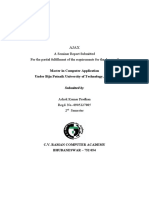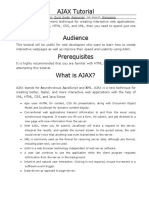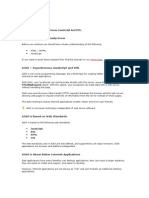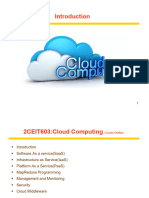Case Study
Case Study
Uploaded by
Tejas JamdadeCopyright:
Available Formats
Case Study
Case Study
Uploaded by
Tejas JamdadeCopyright
Available Formats
Share this document
Did you find this document useful?
Is this content inappropriate?
Copyright:
Available Formats
Case Study
Case Study
Uploaded by
Tejas JamdadeCopyright:
Available Formats
CASE STUDY: AJAX
Introduction
The word AJAX Stands for Asynchronous JavaScript and XML. AJAX is not a new programming language, but a new way to use existing standards. AJAX is the art of exchanging data with a server, and update parts of a web page - without reloading the whole page. This means that it is possible to update parts of a web page, without reloading the whole page. Examples of applications using AJAX such as Google Maps, Gmail, Youtube, and Facebook tabs. Web pages use JavaScript to make asynchronous calls to web-based services that typically return XML.It allows user to continue interacting with web page while waiting for data to be returned. Page can be updated without refreshing browser. It results in a better user experience. AJAX is based on internet standards, and uses a combination of XMLHttpRequest object (to exchange data asynchronously with a server), JavaScript/DOM (to display/interact with the information), CSS (to style the data), XML (often used as the format for transferring data).AJAX applications are browser- and platform-independent.
Working of AJAX Steps of AJAX Operation 1. A client event occurs. 2 .An XMLHttpRequest object is created. 3. The XMLHttpRequest object is configured. 4. The XMLHttpRequest object makes an async.request.
5. The ValidateServlet returns an XML document containing the result. 6. The XMLHttpRequest object calls the callback () function and processes the result. 7. The HTML DOM is updated. Asynchronous In this requests can be made asynchronously or synchronously both techniques allow web page to be updated without refreshing it. Anything useful the user can do while processing request? If yes then use asynchronous, otherwise use synchronous. Asynchronous communication with the server, first we create and send the request and code continues to run and control returns to the user. when the response comes back, it is handled. Benefit is responsiveness and drawback is increased complexity. Javascript Javascript is an object-oriented programming and scripting language that adds interactivity to HTML pages. It is embedded directly into the HTML of documents, and does not require a license to use it. It does not require any special software on the host, but does require browsers that support it. It is not the same as the Java Programming Language, although they are related. Javascript has a smaller set of codes and is easier for the average user to learn. Java is much more complex and allows the developer to create standalone applications, independent of HTML pages. JavaScript function is called when an event in a page occurs. It is dynamic and weakly typed. It is prototypebased with first-class functions. It is semantics similar to functional languages. Javascript is standardized as ECMAScript and supported by most modern browsers. But sometimes disabled for security reasons. Although standardized, browser-specific issues exist. Simple Javascript Example <html> <body> <script type="text/javascript"> <!--document.write("Hello World!") //--> </script></body> </html> Scripts can be entered in the head or body of the document, depending on where you want to execute them. You can also reference an external Javascript page with scripts that can be accessed by multiple pages :< script src="xxx.js"></script> XML XML stands for Extensible Markup Language. It is similar to HTML and is used to describe, share, and store data. Tags are not predefined. Commonly used as a data format for exchanging information with the server such as typically with REST-style web
services . Other possibilities for data formats, often easier to parse and less verbose (network transfer) plain text and JSON. However you must define your own tags. RSS feeds are based on XML. Like XHTML, XML elements must have a closing tag, are case sensitive, and must be properly nested. Element Names Names can contain letters, numbers, and other characters Names must not start with a number or punctuation character Names must not start with the letters xml (or XML, or Xml, etc) Names cannot contain spaces Some Sample XML <?xml version="1.0" encoding="ISO-8859-1"?> <? xml-stylesheet type="text/css" href="cd_catalog.css"?> <CATALOG> <CD> <TITLE>Empire Burlesque</TITLE> <ARTIST>Bob Dylan</ARTIST> <COUNTRY>USA</COUNTRY> <COMPANY>Columbia</COMPANY> <PRICE>10.90</PRICE> <YEAR>1985</YEAR> </CD> <CD> <TITLE>Hide your heart</TITLE> <ARTIST>Bonnie Tyler</ARTIST> <COUNTRY>UK</COUNTRY> <COMPANY>CBS Records</COMPANY> <PRICE>9.90</PRICE> <YEAR>1988</YEAR> </CD>. </CATALOG> XMLHttpRequest It is First introduced by MS as an ActiveX object. The javascript XMLHttpRequest object is used to send a query to the server. It must not be a third party server. The query can be anything that is GET/POST/HEAD. The content comes back to the client (javascript) as an XML document. The client parses the XML and decides what to do (update part of the current HTML document, etc). Creating an XMLHttpRequest Object For IE: http_request = new ActiveXObject("Msxml2.XMLHTTP"); -or possibly
http_request = new ActiveXObject("Microsoft.XMLHTTP"); Netscape/Mozilla/Firefox/Safari: http_request = new XMLHttpRequest (); XMLHttpRequest Properties readyState: Indicates that state of the transaction. 0: uninitialized, 1: loading ... 4 means "done". onreadystatechange: The callback function (async only). responseText: content of the reply as text. responseXML: top of the XML DOM document. status: HTTP status code (200, 404 ...). XMLHttpRequest Methods Open: specify the HTTP method, URL and async/sync Send: initiates the request. Can also specify POST data. Programming with Ajax Client side: 1. Building an HTTP request and sending it. 2. receiving HTTP reply Checking for errors including HTTP errors. 1. Parsing HTTP reply (typically an XML document). 2. Updating HTML elements in the current page. Server side: 1. Generating XML documents 2. The original HTML comes from the server...
Usage cases for AJAX Advanced GUI widgets and controls > Controls such as tree controls, menus, and progress bars may be provided that do not require page refreshes. Refreshing data > HTML pages may poll data from a server for up-to-date data such as scores, stock quotes, weather, or application-specific data. Real-time server-side input form data validation > User IDs, serial numbers, postal codes. > Removes the need to have validation logic at both client side for user responsiveness and at server side for security and other reasons.
Auto-completion > Email address, name, or city name may be auto-completed as the user types. Master detail operation > Based on a user selection, more detailed information can be fetched and displayed. Benefits of AJAX All the benefits of a 'traditional' web application. But allows for... increased responsiveness. More rapid user feedback. Richer user interactions. Desktop application 'look and feel'(More desktop-like UI widgets). Better bandwidth usage when only transferring the data that has changed. Current Issues of AJAX Complexity is increased > Server side developers will need to understand that presentation logic will be required in the HTML client pages as well as in the server-side logic. > Page developers must have JavaScript technology skills. AJAX-based applications can be difficult to debug, test, and maintain > JavaScript is hard to test - automatic testing is hard. > Weak modularity in JavaScript - namespace collision possible. > Lack of design patterns or best practice guidelines yet. Toolkits/Frameworks still maturing No standardization of the XMLHttpRequest yet > Future version of IE will address this. No support of XMLHttpRequest in old browsers > Iframe will help. JavaScript technology dependency & incompatibility > Must be enabled for applications to function. > Still some browser incompatibilities. JavaScript code is visible to a hacker > Poorly designed JavaScript code can invite security problem. AJAX Futures AJAX-enabled JSF Component libraries. Standardization of XMLHttpRequest. Better browser support. Better and Standardized Framework support. More best practice guidelines in the programming model.
You might also like
- Information Management - Lecture Notes, Study Material and Important Questions, AnswersDocument4 pagesInformation Management - Lecture Notes, Study Material and Important Questions, AnswersM.V. TVNo ratings yet
- VSICM7 M04 Vcenter ServerDocument102 pagesVSICM7 M04 Vcenter Serverhacker_05No ratings yet
- Railway Reservation System Build in Visual BasicDocument68 pagesRailway Reservation System Build in Visual BasicMohsin Saqlaini85% (60)
- Enhancement FB60Document6 pagesEnhancement FB60Raavi Sai KumarNo ratings yet
- Unit 3Document37 pagesUnit 3Anuj SoodNo ratings yet
- Ajax TutorialDocument7 pagesAjax Tutorialapi-278351473No ratings yet
- Seminar On AjaxDocument16 pagesSeminar On AjaxMahendra20120% (1)
- Rich Internet Application Technology: AJAX Is Based On Open StandardsDocument5 pagesRich Internet Application Technology: AJAX Is Based On Open StandardsAnonymous rcmeSfj5No ratings yet
- Module 5Document49 pagesModule 5ogiridharreddyNo ratings yet
- What Is AJAX ?Document24 pagesWhat Is AJAX ?anon-783654No ratings yet
- AjaxDocument52 pagesAjaxjolieprincesseishimweNo ratings yet
- Module 5Document24 pagesModule 5Mohd Mushtaq TalikotiNo ratings yet
- AJAXDocument6 pagesAJAXkunjukukku20No ratings yet
- FSD Module 5 NotesDocument13 pagesFSD Module 5 NotesSHARMA RASISHARMANo ratings yet
- Ajax Vs Non AjaxDocument5 pagesAjax Vs Non AjaxsohilnikhilNo ratings yet
- Ajax FrameworkDocument6 pagesAjax Frameworknitin saraswatNo ratings yet
- Ajax PDFDocument71 pagesAjax PDFIsha ShaikhNo ratings yet
- AJAXDocument20 pagesAJAXbinzbinzNo ratings yet
- Ajax NotesDocument14 pagesAjax NotesRaja RajNo ratings yet
- WEB 2.0 Programming With AjaxDocument52 pagesWEB 2.0 Programming With AjaxRahul PraharajNo ratings yet
- What You Should Already Know: Ajax Asynchronous Javascript and XMLDocument13 pagesWhat You Should Already Know: Ajax Asynchronous Javascript and XMLshah_karan_2No ratings yet
- Ruth Betcher Ruth ChristieDocument27 pagesRuth Betcher Ruth ChristieAshwani Kumar MauryaNo ratings yet
- This Essay: Q.N o Questions 1 AnsDocument9 pagesThis Essay: Q.N o Questions 1 Ansmail2kandolaNo ratings yet
- Ajax PresentationDocument20 pagesAjax Presentationsree_rockzzNo ratings yet
- A Seminar Report Submitted For The Partial Fulfillment of The Requirements For The Degree ofDocument15 pagesA Seminar Report Submitted For The Partial Fulfillment of The Requirements For The Degree ofAshok PradhanNo ratings yet
- AJAXDocument10 pagesAJAXP Srinivas ReddyNo ratings yet
- AjaxDocument7 pagesAjaxUsman AziZNo ratings yet
- Unit-7Document19 pagesUnit-7Super heroNo ratings yet
- AJAX NotesDocument12 pagesAJAX NotesBhuvanNo ratings yet
- FSD Module-5 NotesDocument33 pagesFSD Module-5 NotesShreya RangacharNo ratings yet
- Ajax 101Document59 pagesAjax 101Suraj Rajendra0% (1)
- Asynchronous Javascript and XMLDocument26 pagesAsynchronous Javascript and XMLAkif KhanNo ratings yet
- Updated Assignment1 1117818 1113556Document10 pagesUpdated Assignment1 1117818 1113556Noorkhalida AzmiNo ratings yet
- Tutorial: W3Schools Home Next ChapterDocument19 pagesTutorial: W3Schools Home Next ChapterSiddique AhmadNo ratings yet
- Ajax Asynchronous Javascript and XML: Advantages Vs DisadvantagesDocument5 pagesAjax Asynchronous Javascript and XML: Advantages Vs DisadvantagesSiva KumarNo ratings yet
- Conditionals Loops Jumps: CompatibilityDocument4 pagesConditionals Loops Jumps: CompatibilityBairagalla AshokNo ratings yet
- Lecture 5 - AjaxDocument42 pagesLecture 5 - AjaxGaafar MohammedNo ratings yet
- Ajax:: AJAX, Is A Web Development Technique For Creating Interactive Web ApplicationsDocument7 pagesAjax:: AJAX, Is A Web Development Technique For Creating Interactive Web ApplicationsvenkateshNo ratings yet
- Rajnish 2Document5 pagesRajnish 2Ashwani DayalNo ratings yet
- Advance Web TechnologiesDocument46 pagesAdvance Web TechnologiesRydhm BeriNo ratings yet
- Tutorial: What You Should Already KnowDocument18 pagesTutorial: What You Should Already KnowFazeela VsNo ratings yet
- AJAXweb Yenyewe Important NotesDocument4 pagesAJAXweb Yenyewe Important NotesElijahBluxeGithagaNo ratings yet
- A Synchronous Javascript Technology and XMLDocument18 pagesA Synchronous Javascript Technology and XMLkishoreramanaNo ratings yet
- bcs053 Web ProgrammingDocument33 pagesbcs053 Web ProgrammingSatyamNo ratings yet
- What Is Partial Page RenderingDocument5 pagesWhat Is Partial Page RenderingcharlestcpNo ratings yet
- Assignment DCA8241 MCA 4 AWP 2114101746Document9 pagesAssignment DCA8241 MCA 4 AWP 2114101746suman mogNo ratings yet
- LASICT Programming Q4 w304.15 19.24Document11 pagesLASICT Programming Q4 w304.15 19.24Godfrye Blando WenceslaoNo ratings yet
- AJAX TutorialDocument21 pagesAJAX TutorialDejan SindjelicNo ratings yet
- AJAX (Aswathy Gave Me)Document4 pagesAJAX (Aswathy Gave Me)mohdshaheerkmNo ratings yet
- Ajax (Programming) : Ajax (Also AJAX Pronounced andDocument3 pagesAjax (Programming) : Ajax (Also AJAX Pronounced andAdonis AdonicoNo ratings yet
- Apex and Ajax HowDocument12 pagesApex and Ajax Howאבירם סטוינסקיNo ratings yet
- Asynchronous Javascript and XML - Java ImplementationDocument31 pagesAsynchronous Javascript and XML - Java ImplementationMohamedNo ratings yet
- Web Technology Introduction Collin Smith (Dec. 16, 2006)Document12 pagesWeb Technology Introduction Collin Smith (Dec. 16, 2006)Aarti DograNo ratings yet
- Ajax Tutorial - A Beginner's Guide - A Step by Step ProcessDocument126 pagesAjax Tutorial - A Beginner's Guide - A Step by Step ProcessCesarNo ratings yet
- AJAX & Web ServicesDocument6 pagesAJAX & Web ServicesliloooooooooooNo ratings yet
- Cs2358 Internet Programming LabDocument19 pagesCs2358 Internet Programming LabHari PrasathNo ratings yet
- AOT Unit-1 - MergedDocument86 pagesAOT Unit-1 - MergedmohitandvivekNo ratings yet
- 11 AjaxDocument35 pages11 Ajaxamme_puspitaNo ratings yet
- Ajax Stands Fora Synchronous Javascript and XMLDocument25 pagesAjax Stands Fora Synchronous Javascript and XMLbumboleNo ratings yet
- Who's Using Ajax ?Document11 pagesWho's Using Ajax ?npipaliyaNo ratings yet
- Module5 (2)Document86 pagesModule5 (2)acharyaramya412No ratings yet
- Unit-V: Introduction To AJAXDocument32 pagesUnit-V: Introduction To AJAXRAVI TEJA MNo ratings yet
- 3.1 Usage of Ajax and JsonDocument18 pages3.1 Usage of Ajax and JsonntwaliisimbivieiraNo ratings yet
- SAP PO Mapping Sync SOAP To JDBC - Jaehoo WeblogDocument4 pagesSAP PO Mapping Sync SOAP To JDBC - Jaehoo WeblogJosé Alberto Sánchez GonzálezNo ratings yet
- Intermediate CodeDocument19 pagesIntermediate Codeipo ipoNo ratings yet
- MS PowerAppsDocument2,262 pagesMS PowerAppsBình HồNo ratings yet
- BOARD EXAM QUESTIONS ON ArraysDocument6 pagesBOARD EXAM QUESTIONS ON ArraysAD SOLUTIONSNo ratings yet
- Data Architecture Project Presentation - Modern StatspptxDocument21 pagesData Architecture Project Presentation - Modern StatspptxPatricio Ernesto RepettoNo ratings yet
- 1.disabling Interrupts:: Mutual Exclusion With Busy WaitingDocument2 pages1.disabling Interrupts:: Mutual Exclusion With Busy WaitingsuwaskNo ratings yet
- 06 Web Authoring SoftwareDocument4 pages06 Web Authoring SoftwareThee AlchemistNo ratings yet
- How To Become A SDETDocument4 pagesHow To Become A SDETSyntax TechnologiesNo ratings yet
- An Introduction To LibuvDocument61 pagesAn Introduction To LibuvCarlos Benitez FieldNo ratings yet
- SQL AND, OR and NOT OperatorsDocument5 pagesSQL AND, OR and NOT Operatorszainab alhussainyNo ratings yet
- CS-20002 (Os) - CS End April 2024Document13 pagesCS-20002 (Os) - CS End April 2024Shradha SwarupNo ratings yet
- 1648 4170 1 PBDocument11 pages1648 4170 1 PBDul BeNo ratings yet
- Jsr94 SpecDocument42 pagesJsr94 SpecNagasri Ganesh KumarNo ratings yet
- College Management System (Sem 6)_110106Document28 pagesCollege Management System (Sem 6)_110106dalvitanmay15No ratings yet
- Alfian Winardi, Renaldi Adrian Kali Linux Gaining Access AndroidDocument10 pagesAlfian Winardi, Renaldi Adrian Kali Linux Gaining Access Androidsamagan nurdNo ratings yet
- Ejercicios K. Louden Impares PDFDocument54 pagesEjercicios K. Louden Impares PDFJose Salavert MorenoNo ratings yet
- Clauses in OracleDocument9 pagesClauses in OracleNilesh KumarNo ratings yet
- SDA JetPackBook enDocument32 pagesSDA JetPackBook enLorena LorenaNo ratings yet
- IntroductionDocument61 pagesIntroductionmehulprajapati1661No ratings yet
- Michael Collins: Work ExperienceDocument2 pagesMichael Collins: Work ExperienceAman RajNo ratings yet
- Mini Project1Document47 pagesMini Project1Manu Kumar0% (1)
- The HTML Element: HTML and ElementsDocument6 pagesThe HTML Element: HTML and Elementsmd jahidNo ratings yet
- PSCAD V5 - HPC Brochure 2023Document2 pagesPSCAD V5 - HPC Brochure 2023vaucejoNo ratings yet
- Assignment C++ ProgrammingDocument10 pagesAssignment C++ ProgrammingAana SolehahNo ratings yet
- AD01Document7 pagesAD01lolaff379No ratings yet
- ACE TutorialDocument156 pagesACE TutorialbthygesenNo ratings yet

























































































